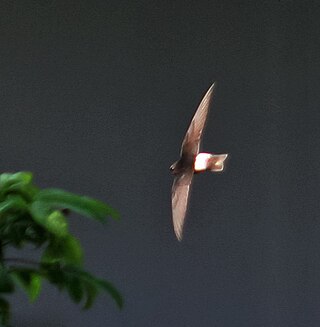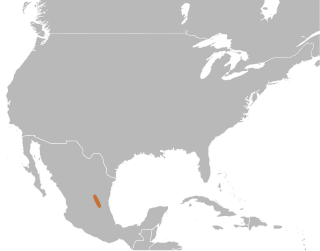
The western mosquitofish is a North American freshwater fish, also known commonly, if ambiguously, as simply mosquitofish or by its generic name, Gambusia, or by the common name gambezi. Its sister species, the eastern mosquitofish is also referred to by these names.

The little swift, is a small species of swift found in Africa and southwestern Asia, and are vagrants and local breeders in southern Europe. They are found both in urban areas and at rocky cliffs where they build nests in a way typical of all members of the order Apodiformes. The genus name Apus is Latin for a swift, thought by the ancients to be a type of swallow without feet. The Latin specific affinis means similar to or related to, but in this case the species that the little swift supposedly resembles is not clear from the description. A population formerly considered to be an eastern subspecies of little swift is now separated as a distinct species, the house swift.

Hypsiglena is a genus of small, rear-fanged, colubrid snakes commonly referred to as night snakes. The genus consists of nine species, and subspecies have been maintained pending further investigation.
The night snake is a species of rear-fanged colubrid. It is found in Mexico.

Hypsiglena jani, commonly known as the Texas night snake or the Chihuahuan night snake, is a small species of mildly venomous snake in the family Colubridae. The species is native to the southwestern United States and adjacent northeastern Mexico.

The chocolate pipistrelle is a species of vesper bat in the family Vespertilionidae. It is found in China, India, Myanmar, Nepal, and Sri Lanka.

Blyth's frogmouth is a species of bird in the family Podargidae. It lives in the tropical and subtropical moist broadleaf forests of Brunei, Cambodia, Indonesia, Laos, Malaysia, Myanmar, Thailand, and Vietnam, and feeds on invertebrates. It is sometimes considered conspecific with the Javan and Palawan frogmouths.

The black-chested jay is a species of bird in the family Corvidae.

The intermediate horseshoe bat is a bat species of the family Rhinolophidae that is very widespread throughout much of the Indian subcontinent, southern and central China and Southeast Asia. It is listed by IUCN as Least Concern as it is considered common where it occurs, without any known major threats.

The California night snake is a subspecies of small colubrid snake native to California.

Euthynnus affinis, the mackerel tuna, little tuna, wavyback skipjack tuna, kawakawa, or tongkol is a species of ray-finned bony fish in the family Scombridae, or mackerel family. It belongs to the tribe Thunnini, better known as the tunas. This is an Indo-Pacific species which is found from the Red Sea to French Polynesia.

The southern river terrapin is a turtle of the family Geoemydidae found in Malaysia, Indonesia and Cambodia.

"Crocodylus" affinis is an extinct species of crocodyloid from the Eocene of Wyoming. Fossils were first described from the Bridger Formation by American paleontologist Othniel Charles Marsh in 1871. Marsh described the species, along with every other species of crocodyloid in the Bridger Formation, under the genus Crocodylus. The known specimen of "Crocodylus" affinis is a skull found at Grizzly Buttes, Wyoming, measuring 13 inches in length on the upper surface. Recent phylogenetic studies of crocodyloids show that "C." affinis is not a species of Crocodylus, but a genus has not yet been erected to include the species. Other Bridger species such as Crocodylus clavis and Brachyuranochampsa zangerli have been synonymized with "C." affinis.

Bombus affinis, commonly known as the rusty patched bumble bee, is a species of bumblebee endemic to North America. Its historical range in North America has been throughout the east and upper Midwest of the United States, north to Ontario, Canada, where it is considered a "species at risk", east to Quebec, south to Georgia, and west to the Dakotas. Its numbers have declined in 87% of its historical habitat range. On January 10, 2017, the United States Fish and Wildlife Service placed B. affinis on the list of endangered species, making the rusty patched bumblebee the first bee to be added to the list in the continental United States.
Hypsiglena unaocularus, commonly known as the Islas Revillagigedo night snake or Clarión night snake, is a species of small colubrid snake endemic to Clarion Island, initially described from a single specimen collected by William Beebe in 1936. During the next several decades, scientists were unable to detect any trace of the snake in their field studies. After an intensive search in 2013, a team of scientist identified 11 snakes that matched the original description of the species. They conducted a series of DNA tests to confirm that the Islas Revillagigedo nightsnake, formerly viewed as the subspecies Hypsiglena torquata unaocularis, is genetically distinct from related mainland snakes and should be recognized as a full species. While never formally declared extinct, this species remained absent from scientific literature due to two main factors: its home on Clarion is extremely remote and only accessible by military escort, significantly restricting the number of biologists who can access this area, and the snake's secretive, nocturnal behavior and dark coloration make it difficult to detect in the field. Because of the lack of follow-up sightings, scientists long presumed that Beebe had provided an incorrect locality for his specimen.
Isla Coronados, is an island in the Gulf of California east of the Baja California Peninsula in Baja California Sur state, Mexico. The island is uninhabited and is part of the Loreto Municipality.
Hypsiglena chlorophaea, the desert night snake, is a species of snake in the family Colubridae. The species is native to Mexico and the United States.

Hypsiglena ochrorhynchus, the spotted night snake, is a species of snake in the family Colubridae. The species is native to Mexico and the United States.
Hypsiglena slevini, the Baja California night snake, is a species of snake in the family Colubridae. The species is native to Mexico.

Hypsiglena tanzeri, the Rio Verde night snake or Tanzer's night snake, is a species of snake in the family Colubridae. The species is native to Mexico.













